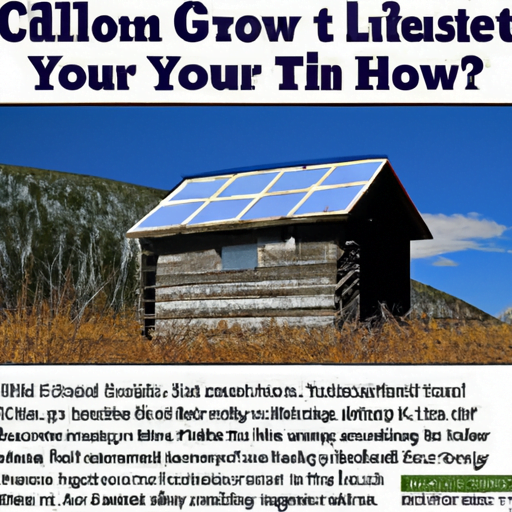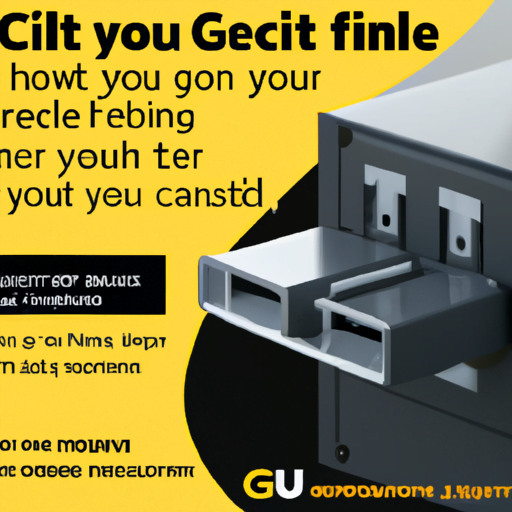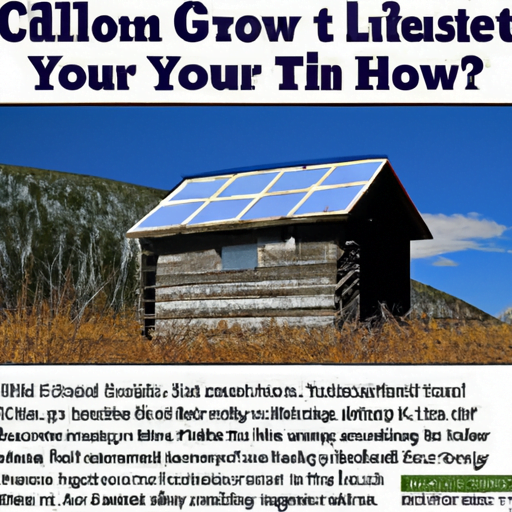Do you ever dream of escaping the hustle and bustle of city life and finding solace in an off-grid cabin? Picture it – surrounded by nature, far away from the noise and chaos. It sounds like a dream come true, doesn’t it? But here’s the thing, you can’t just plop down a cabin in the middle of nowhere and expect it to have electricity magically flowing through its walls. So, how do you power your off-grid cabin?
Well, my friend, I’m here to tell you that it’s not as daunting as it may seem. There are actually several options to consider when it comes to supplying power to your off-grid hideaway. From solar panels and wind turbines to diesel generators and hydroelectric power, the choices are aplenty. Each option has its own set of advantages and disadvantages, but fear not, because in this article, we’ll explore them all in detail, giving you the lowdown on what will work best for your specific needs.
Whether you’re planning on using your off-grid cabin as a weekend getaway or a permanent residence, it’s crucial to have a reliable power source. After all, you’ll need electricity for lighting, refrigeration, cooking, and charging your devices. But before we dive into the nitty-gritty of each power option, let’s take a step back and consider some key factors that will influence your decision. These factors include your location, available natural resources, budget, and energy requirements. So, get ready to embark on this electrifying journey and discover the secrets to powering your off-grid cabin!
Introduction
Living off-grid has become increasingly popular in recent years, as people seek to live a more sustainable and self-sufficient lifestyle. Whether you’re a nature enthusiast looking for a rustic retreat or someone who wants to reduce their carbon footprint, powering your off-grid cabin is an essential consideration. In this article, we will explore the different ways you can generate power for your off-grid cabin and help you make an informed decision based on your needs and the available resources.
Understanding Off-Grid Living
What is Off-Grid Living?
Off-grid living refers to a lifestyle where individuals or families are self-sufficient and not dependent on public utilities such as electricity, water, or gas. Being off the grid means generating your own power, collecting rainwater or using a well, and utilizing alternative methods for heating and cooling. It requires a shift in mindset and a commitment to sustainable living practices.
Benefits of Off-Grid Living
The benefits of off-grid living are numerous. Firstly, it allows you to become independent from the grid, giving you control over your energy consumption and reducing the impact on the environment. Additionally, living off the grid can save you money in the long run, as you won’t be relying on pricey utility bills. It also promotes a closer connection with nature and encourages a simpler, more minimalistic way of life.
Challenges of Off-Grid Living
While off-grid living has its benefits, it also presents some unique challenges. One of the main challenges is the initial cost of setting up the necessary infrastructure for generating power. Depending on the method you choose, it may require a significant investment upfront. Another challenge is the need for regular maintenance and troubleshooting. Since you are responsible for your own power system, you will need to have a basic understanding of how it works and be prepared to address any issues that may arise.

Powering Your Off-Grid Cabin
Assessing Your Power Needs
Before choosing a power system for your off-grid cabin, it’s important to assess your power needs. Consider the appliances and electronics you plan to use, and estimate their energy consumption. This will help you determine the size of the power system you will require.
Solar Power Systems
Solar power is one of the most popular and widely used methods of generating off-grid electricity. Solar panels convert sunlight into electricity through the photovoltaic effect. When choosing solar panels, consider the efficiency, durability, and size that will work best for your cabin. A solar charge controller is also necessary to regulate the power output and protect your batteries from overcharging.
Wind Power Systems
Harnessing wind energy is another effective way to power your off-grid cabin. Wind turbines convert the kinetic energy of the wind into electricity. When selecting a wind turbine, consider the average wind speed in your area and the power output of the turbine. Additionally, you will need wiring and charge controllers to connect the turbine to your battery bank and inverter.
Hydro Power Systems
If your off-grid cabin is situated near a water source such as a stream or river, hydro power can be a viable option. Hydro turbines convert the flow of water into mechanical energy, which is then transformed into electricity. Choose a turbine size that matches the flow rate of your water source and consider the control mechanisms necessary to regulate the water flow. A battery bank and inverter will be needed to store and convert the generated electricity.
Generator Power Systems
Having a backup power solution is crucial for off-grid living. A generator can provide power during periods of low renewable energy production or in emergencies. When selecting a generator, consider factors such as fuel efficiency, noise levels, and maintenance requirements. It’s important to note that a generator should only be used as a supplementary power source and not as the primary method of generating electricity.
Assessing Your Power Needs
Calculating Energy Consumption
Calculating your energy consumption will help you determine the size and capacity of your power system. Start by creating a list of all the appliances and electronics you plan to use in your off-grid cabin. Then, find their power ratings (usually measured in watts) and estimate the average daily usage. Multiply the power rating by the usage time to determine the daily energy consumption of each device. Sum up the energy consumption of all devices to get an idea of your total power needs.
Determining Peak Power Demands
In addition to assessing your daily energy consumption, it’s important to consider peak power demands. Some appliances, such as refrigerators or air conditioning units, require a higher starting power (known as the surge or peak power) than their normal running power. Make sure your power system can handle these peak power demands to avoid overloading or damaging your system.

Solar Power Systems
How Solar Power Works
Solar power works by converting sunlight into electricity through the photovoltaic effect. When sunlight hits the solar panels, the panels generate direct current (DC) electricity. The DC electricity is then converted to alternating current (AC) electricity using an inverter, which can be used to power your appliances and electronics.
Selecting Solar Panels
When selecting solar panels for your off-grid cabin, consider factors such as efficiency, durability, and size. High-efficiency panels produce more electricity per square foot, allowing you to generate more power in limited space. Look for panels that are reliable and can withstand the weather conditions in your area.
Solar Charge Controllers
A solar charge controller is an essential component of any solar power system. It regulates the power output from the solar panels and prevents overcharging of the batteries. There are two main types of solar charge controllers: PWM (Pulse Width Modulation) and MPPT (Maximum Power Point Tracking). MPPT charge controllers are more efficient and can make better use of the available solar power.
Batteries and Inverters
Batteries are necessary for storing the excess electricity generated by your solar panels. The stored energy can then be used during periods of low sunlight or at night. Choose batteries that are specifically designed for deep-cycle applications, as they are more suitable for frequent charging and discharging. Inverters, on the other hand, convert the DC electricity stored in the batteries into AC electricity that can be used to power your appliances and electronics.
Wind Power Systems
Harnessing Wind Energy
Wind power systems generate electricity by converting the kinetic energy of the wind into electrical energy. Wind turbines consist of rotor blades that rotate when the wind blows. The rotor blades are connected to a generator, which produces electricity as it spins. The electricity generated can be stored in batteries for later use.
Choosing Wind Turbines
When choosing a wind turbine for your off-grid cabin, consider factors such as the average wind speed in your area and the power output of the turbine. Higher wind speeds result in more power generation, so it’s important to select a turbine that matches the wind conditions in your location.
Wiring and Charge Controllers
To connect your wind turbine to your battery bank and inverter, you will need wiring and charge controllers. The charge controller regulates the power output from the wind turbine and ensures that your batteries are charged at the correct voltage and current. Proper wiring is essential to minimize power loss and ensure efficient energy transfer.
Battery Bank and Inverter Setup
Like solar power systems, wind power systems also require batteries and inverters to store and convert the generated electricity. Choose deep-cycle batteries that can handle frequent charging and discharging. Inverters convert the DC electricity stored in the batteries into AC electricity that can be used to power your off-grid cabin.
Hydro Power Systems
Utilizing Water Energy
Hydro power systems harness the energy of flowing water to generate electricity. By utilizing water turbines, the mechanical energy of the flowing water is converted into electrical energy. Hydro power is particularly effective if your off-grid cabin is located near a stream or river with a constant flow of water.
Selecting Hydro Turbines
When selecting a hydro turbine, consider the flow rate and the head of your water source. The flow rate refers to the amount of water that passes through the turbine per unit of time, while the head refers to the vertical distance between the water source and the turbine. The size and type of turbine you choose will depend on the specific characteristics of your water source.
Controlling Water Flow
To regulate the flow of water and optimize power generation, you may need to install a control mechanism such as a sluice gate or a penstock. These devices allow you to adjust the amount of water that reaches the turbine, ensuring a steady and consistent flow.
Battery and Inverter Setup
As with solar and wind power systems, hydro power systems require batteries and inverters to store and convert the generated electricity. Deep-cycle batteries are recommended for hydro power applications, as they can handle the frequent charging and discharging. Inverters are essential for converting the DC electricity stored in the batteries into AC electricity that can be used to power your off-grid cabin.
Generator Power Systems
Backup Power Solution
While renewable energy sources such as solar, wind, and hydro power are the primary methods of generating off-grid electricity, having a backup power solution is crucial. Generators can provide power during periods of low renewable energy production or in emergencies such as severe weather conditions.
Selecting the Right Generator
When selecting a generator for your off-grid cabin, consider factors such as fuel efficiency, noise levels, and maintenance requirements. Choose a generator that is capable of producing the required power output to meet your needs. It’s important to note that generators should only be used as a supplementary power source and not as the primary method of generating electricity in an off-grid cabin.
Fuel Efficiency and Maintenance
To ensure a reliable and efficient power supply, it’s important to choose a generator that is fuel-efficient. Look for generators that have low fuel consumption and can operate for longer periods on a single tank of fuel. Regular maintenance, such as oil changes and filter replacements, is also necessary to keep your generator running smoothly.
Maintenance and Troubleshooting
Regular System Checks
To ensure the optimal performance of your off-grid power system, regular system checks are essential. Inspect your solar panels, wind turbines, or hydro turbines for any signs of damage or debris buildup. Check the connections and wiring to ensure they are secure and functioning properly. Regular maintenance will help extend the lifespan of your equipment and prevent potential problems.
Cleaning Solar Panels and Turbines
Solar panels and turbines require regular cleaning to maximize their efficiency. Remove any dust, dirt, or debris from the surface of the solar panels using a soft brush or cloth. For wind turbines, clean the blades to remove any accumulated dirt or bird droppings. Regular cleaning will help maintain the performance of your renewable energy systems.
Troubleshooting Common Issues
Like any power system, off-grid systems can encounter issues from time to time. Some common issues include battery failure, wiring problems, or faulty charge controllers. Familiarize yourself with the troubleshooting procedures for your specific system and be prepared to address any issues that may arise. If necessary, consult a professional for assistance.
Conclusion
Powering your off-grid cabin requires careful planning and consideration of your power needs, available resources, and environmental conditions. Whether you choose solar, wind, hydro, or a combination of these methods, it’s important to select the right system for your specific situation. With proper installation, maintenance, and troubleshooting, you can enjoy the benefits of a sustainable and self-sufficient lifestyle in your off-grid cabin.




